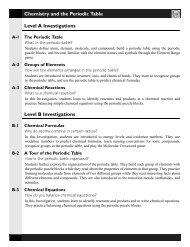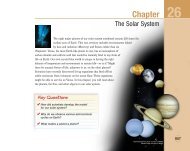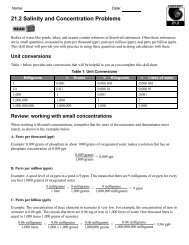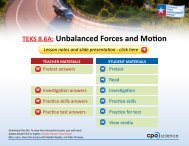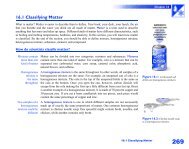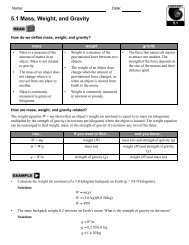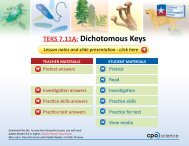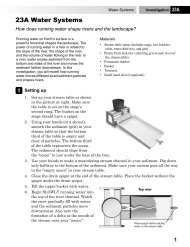Solubility - CPO Science
Solubility - CPO Science
Solubility - CPO Science
- No tags were found...
You also want an ePaper? Increase the reach of your titles
YUMPU automatically turns print PDFs into web optimized ePapers that Google loves.
Name:23.3 <strong>Solubility</strong>Question: What factors affect solubility?ABExperiment 1: temperature and solubilityThere are no questions to answer in part 1.ProcedureSafety Tip: Carefully follow your teacher’s directions for working with the hotwater. Take care not to spill it on yourself or others.As you complete the procedures, record your observations of the sugar cubes at each temperaturebelow. Record your data from the experiment in Tables 1, 2, and 3 on the next page.Temperature range What happens tothe color on thesugar cube?What happens toa sugar cube as itdissolves?What does thewater above thesugar cube looklike?Ice water(blue)Room temperaturewater(green)Hot water(red)What do you notice about the water above the sugar? Record your observations in the space below.Answer Sheet23.3 <strong>Solubility</strong>
Data tables for part 2.Table 1: Starting and ending temperatures for the experimentTemperature range Starting temperature (°C) Ending temperature (°C)Ice water(blue)Room temperature water(green)Hot water(red)Table 2: Starting and ending times for the experimentStart time for experimentminutes:secondsEnd time for experimentminutes:secondsTable 3: Sugar cube dataNumber ofcubesTime recorded whencube dissolves in icewaterTime recorded whencube dissolves inroom temperaturewaterTime recorded whencube dissolves in hotwater12323.3 <strong>Solubility</strong> Answer Sheet
CAnalyzing your resultsa. In which beaker of water did three sugar cubes dissolve the fastest? In which beaker of water did thesugar cubes dissolve the slowest?b. Did the ice water stay colder than the room temperature water for the whole experiment? Did the hotwater stay warmer than the room temperature water for the whole experiment? Why was it important tocheck the water temperature in each beaker at the start and at the end of the experiment?DHow does temperature influence solubility?a. List three observations you made during the experiment. Use what you know about solubility toexplain each of these observations. In other words, describe why something you observed occurred orlooked a certain way.b. Based on your observations of the experiment and your own ideas, draw a diagram that shows howtemperature influences how a substance dissolves on the molecular level.Answer Sheet23.3 <strong>Solubility</strong>
EExperiment 2: pressure and solubilitya. How do you know that the liquid in the bottle is under pressure?b. How do you know that the liquid contains a dissolved gas?c. What do you think will happen to the gas dissolved in the liquid after you take the cap off?FProcedureWear goggles during this part of the Investigation. Work carefully.There are no questions to answer in part 6.GDrawing conclusionsa. What happened to the balloon as you unscrewed the cap?b. Are the bubbles in the liquid large or small just after you take off the cap?23.3 <strong>Solubility</strong> Answer Sheet
c. How has the balloon changed since you first opened the bottle? What does the change in size tell youabout the amount of gas in the balloon and where did the gas come from?d. Has the size of the bubbles in the liquid changed since you opened the bottle? If so, come up with areason to explain why this might have happened.e. Why was the balloon important in this Investigation?f. How did the pressure change before and after opening the bottle?g. How did you know the pressure changed?Answer Sheet23.3 <strong>Solubility</strong>
h. Based on the results and your observations from the experiment, how was the solubility of carbondioxide gas in water affected by the pressure in the bottle? Use evidence from the Investigation in yourresponse.i. Make a prediction for how the seltzer will taste a week from now if the bottle is left open. Explain yourprediction using the terms pressure and solubility.23.3 <strong>Solubility</strong> Answer Sheet
HChallenge questionsa. Soft drinks contain dissolved carbon dioxide that has been added to make a carbonated solution. Thecarbon dioxide is kept in solution using pressure. If you were going to start a company that makescarbonated soda, what kind of processes would you use to make and package the soda in aluminumcans? Write out and diagram your ideas on a blank piece of paper. Once you have recorded your ideas,do some research at the local library or on the Internet to see how your ideas compare to real worldpractices for making and packaging carbonated soda. Include your ideas in the space below.b. In this part of the Investigation, we only looked at the solubility of a gas in a liquid. How do you thinkpressure affects the solubility of a liquid in a liquid or a solid in a liquid? How do you thinktemperature would affect the solubility of a gas in a liquid? Provide evidence to support your ideas.Answer Sheet23.3 <strong>Solubility</strong>
c. Read “<strong>Science</strong> in the Real World: Scuba diving” in section 23.3 <strong>Solubility</strong> of the student text. Based onthis reading and what you observed in the Investigation, explain why you need to understand theinfluence of pressure on the solubility of a gas in order to scuba dive safely.23.3 <strong>Solubility</strong> Answer Sheet



